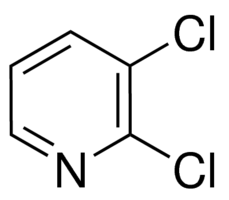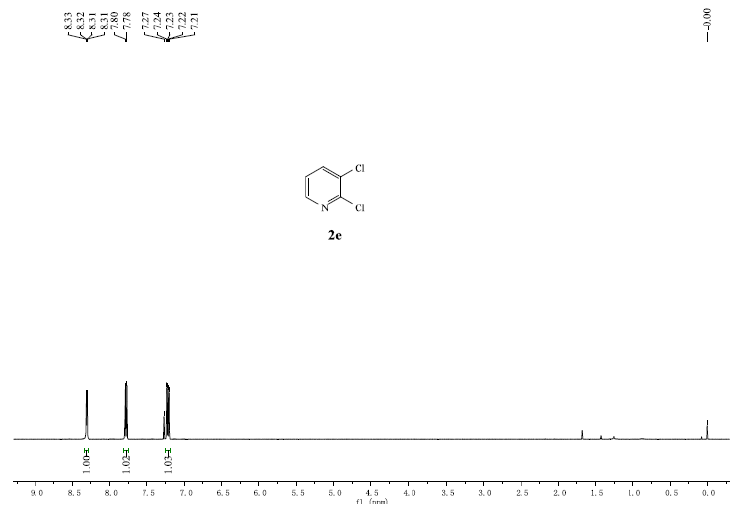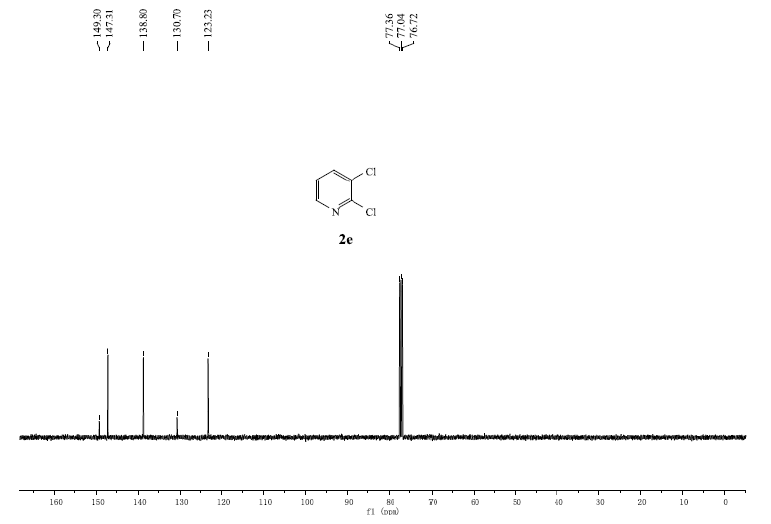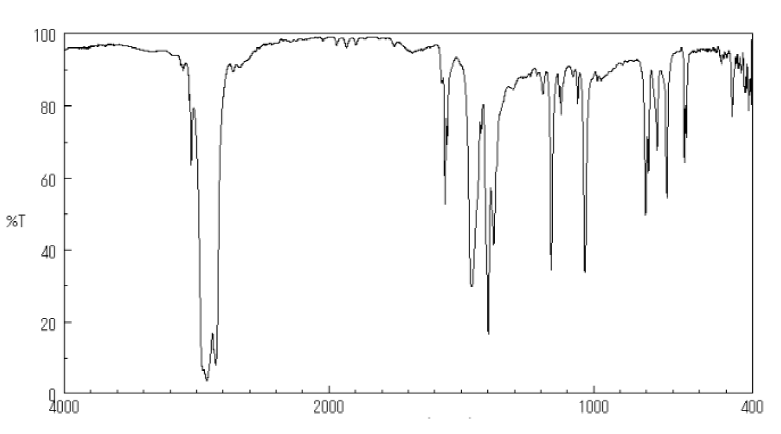2,3-Dichloropyridine CAS#: 2402-77-9; ChemWhat Code: 5111
Identification
| Product Name | 2,3-Dichloropyridine |
| IUPAC Name | 2,3-dichloropyridine |
| Molecular Structure |  |
| CAS Registry Number | 2402-77-9 |
| EINECS Number | 219-281-8 |
| MDL Number | MFCD00006229 |
| Beilstein Registry Number | 109811 |
| Synonyms | 2,3-dichloro-pyridine, 2,3-dichloropyridine, 2-chloronicotinyl chloride, 2,3-Dichloropyridine, 2.3-dichloropyridine, dichloropyridine, 2,3-Dichlor-pyridin |
| Molecular Formula | C5H3Cl2N |
| Molecular Weight | 147.990 |
| InChI | InChI=1S/C5H3Cl2N/c6-4-2-1-3-8-5(4)7/h1-3H |
| InChI Key | MAKFMOSBBNKPMS-UHFFFAOYSA-N |
| Canonical SMILES | c1cc(c(nc1)Cl)Cl |
| Patent Information | ||
| Patent ID | Title | Publication Date |
| WO2021/76832 | METHODS FOR THE PREPARATION OF 5-BROMO-2-(3-CHLORO-PYRIDIN-2-YL)-2H-PYRAZOLE-3-CARBOXYLIC ACID | 2021 |
| CN105153022 | 3 – Ethylsulfonyl – 2 – pyridine sulfonamide and intermediate preparation method | 2018 |
| US2013/230459 | RADIOLABELLED mGluR2 PET LIGANDS | 2013 |
| US2014/371204 | 4-(Benzoimidazol-2-yl)-thiazole Compounds and Related Aza Derivatives | 2014 |
Physical Data
| Appearance | White to off-white solid |
| Solubility | slightly soluble |
| Boilling Point | 242.42°C (rough estimate) |
| Refractive index | 1.5500 (estimate) |
| Melting Point, °C | Solvent (Melting Point) |
| 46 – 48 | |
| 64.5 – 66.8 | |
| 77 – 79 | |
| 65 | cyclohexane |
| 64.5 – 66 | methanol, H2O |
| Boiling Point, °C |
| 202.5 – 203.5 |
| Density, g·cm-3 | Reference Temperature, °C | Measurement Temperature, °C |
| 1.14 | 4 | 25 |
| 1.2 | 4 | -190 |
| 1.24 |
Spectra
| Description (NMR Spectroscopy) | Nucleus (NMR Spectroscopy) | Solvents (NMR Spectroscopy) | Frequency (NMR Spectroscopy), MHz |
| Chemical shifts | 1H | chloroform-d1 | |
| Chemical shifts, Spectrum | 1H | chloroform-d1 | 400 |
| Chemical shifts, Spectrum | 13C | chloroform-d1 | 100 |
| Chemical shifts | 13C | dimethylsulfoxide-d6 | 400 |
| Chemical shifts | 1H | dimethyl sulfoxide | 101 |
| Spectrum | 1H | chloroform-d1 | 400 |
| Spectrum | 1H | dimethylsulfoxide-d6 | 400 |
| Spin-spin coupling constants | CDCl3 | ||
| NMR |
| Description (IR Spectroscopy) | Solvent (IR Spectroscopy) | Temperature (IR Spectroscopy), °C |
| Spectrum | melt | 785 – 740 cm**(-1) |
| Spectrum | CS2 | 785 – 740 cm**(-1) |
| Bands | nujol | 3058 – 38 cm**(-1) |
| Bands | gas | 3067 – 474 cm**(-1) |
| Bands | melt | 3063 – 475 cm**(-1) |
| Bands | CS2 | 3064 – 474 cm**(-1) |
| IR |
| Description (UV/VIS Spectroscopy) | Solvent (UV/VIS Spectroscopy) | Absorption Maxima (UV/VIS), nm |
| Absorption maxima | cyclohexane | 265.25, 261.5 |
| Absorption maxima | cyclohexane | 281.02, 276.19, 272.93, 268.61 |
| UV/VIS |
Route of Synthesis (ROS)
| Conditions | Yield |
| With N-Methyldiethanolamine; hydrazine hydrate at 102 – 105℃; under 2250.23 – 3000.3 Torr; for 8h; Inert atmosphere; Autoclave; Large scale; | 98.12% |
| With hydrazine hydrate In ethanol for 25h; Reflux; | 97.6% |
| With hydrazine hydrate In ethanol for 25h; Reflux; | 96% |
Safety and Hazards
| Pictogram(s) |  |
| Signal | Warning |
| GHS Hazard Statements | H302 (12.24%): Harmful if swallowed [Warning Acute toxicity, oral] H315 (100%): Causes skin irritation [Warning Skin corrosion/irritation] H319 (100%): Causes serious eye irritation [Warning Serious eye damage/eye irritation] H335 (97.96%): May cause respiratory irritation [Warning Specific target organ toxicity, single exposure; Respiratory tract irritation] Information may vary between notifications depending on impurities, additives, and other factors. |
| Precautionary Statement Codes | P261, P264, P270, P271, P280, P301+P312, P302+P352, P304+P340, P305+P351+P338, P312, P321, P330, P332+P313, P337+P313, P362, P403+P233, P405, and P501 (The corresponding statement to each P-code can be found at the GHS Classification page.) |
Other Data
| Transportation | NONH for all modes of transport |
| Under the room temperature and away from light | |
| HS Code | No data available |
| Storage | Under the room temperature and away from light |
| Shelf Life | 2 years |
| Market Price | USD |
| Druglikeness | |
| Lipinski rules component | |
| Molecular Weight | 147.992 |
| logP | 2.103 |
| HBA | 1 |
| HBD | 0 |
| Matching Lipinski Rules | 4 |
| Veber rules component | |
| Polar Surface Area (PSA) | 12.89 |
| Rotatable Bond (RotB) | 0 |
| Matching Veber Rules | 2 |
| Use Pattern |
| 2,3-Dichloropyridine CAS#: 2402-77-9 mainly used as pharmaceutical intermediates. |
| 2,3-Dichloropyridine CAS#: 2402-77-9 mainly used as pesticide intermediates. |
Buy Reagent | |
| No reagent supplier? | Send quick inquiry to ChemWhat |
| Want to be listed here as a reagent supplier? (Paid service) | Click here to contact ChemWhat |
Approved Manufacturers | |
| Caming Pharmaceutical Ltd | http://www.caming.com/ |
| Want to be listed as an approved manufacturer (Requires approvement)? | Please download and fill out this form and send back to approved-manufacturers@chemwhat.com |
Other Suppliers | |
| Watson International Limited | Visit Watson Official Website |
Contact Us for Other Help | |
| Contact us for other information or services | Click here to contact ChemWhat |





